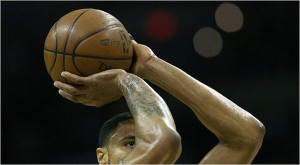Why Hasn’t Free Throw Shooting Improved?

Tyson Chandler of the New Orleans Hornets took a free throw against the San Antonio Spurs in 2008. (Ronald Martinez/Getty Images)
I’m at best a casual fan of basketball but this is an interesting fact: Whereas just about every aspect of athletic performance in just about every sport has improved over the years, “one thing has remained remarkably constant: the rate at which players make free throws.”
Since the mid-1960s, college men’s players have made about 69 percent of free throws, the unguarded 15-foot, 1-point shot awarded after a foul. In 1965, the rate was 69 percent. This season, as teams scramble for bids to the N.C.A.A. tournament, it was 68.8. It has dropped as low as 67.1 but never topped 70.
In the National Basketball Association, the average has been roughly 75 percent for more than 50 years. Players in college women’s basketball and the W.N.B.A. reached similar plateaus — about equal to the men — and stuck there.
The explantion for why it hasn’t changed? Well, nothing has changed:
Ray Stefani, a professor emeritus at California State University, Long Beach, is an expert in the statistical analysis of sports. Widespread improvement over time in any sport, he said, depends on a combination of four factors: physiology (the size and fitness of athletes, perhaps aided by performance-enhancing drugs), technology or innovation (things like the advent of rowing machines to train rowers, and the Fosbury Flop in high jumping), coaching (changes in strategy) and equipment (like the clap skate in speedskating or fiberglass poles in pole vaulting).
The ball’s the same, the rim’s the same, the distance is the same. The athletes are stronger but it has little bearing on this aspect of the game. And coaching? Well, coaches spend about as much time on it as they always did. Why?
There is little correlation between free-throw percentages and winning percentages. Only one of the 25 best shooting teams, No. 2 North Carolina, is also in the latest Associated Press top 25 rankings. Southern Utah [ranked No. 1 at 80.5 percent] has a losing record.
Perhaps that’s because it’s one aspect of your game that the opponent can control. If you’re a good free throw shooting team, they’ll foul less.
Moreover, there would seem to be diminishing returns. If the best team is at 80.5 percent and the average is 70 percent, how much practice time do you want to devote at the expense of other skills?
via Tyler Cowen
- Investment Banker Assists Mavericks At The Line
- Its Good To Be Shaq, Not Horry
- NBA calls for do-over in Atlanta Hawks- Miami Heat game
- NFL Ticket Averages $62.38, up 5.6 percent
- Former Arizona State sports coach William Kajikawa dead at 97
- Jet carrying Russian professional hockey team crashes
- Legendary UCLA Basketball Coach John Wooden Dies At 99
- NFL Coaches Going for it on 4th Down More
- MLB Players Like Jim Joyce, Don’t Like Instant Replay
- Colorado Rockies sign C Miguel Olivo
- Eight is Enough- Edmonton beats Chicago 8-4
- Lydia Ko wins New South Wales Open
- The Comeback I- Pittsburgh Penguins beat NY Islanders 5-0
- Seattle Mariners Outfielder Greg Halman stabbed to death at age 24
- Hee Young Park wins CME Titleholders Championship
- Oklahoma State Women’s Basketball Coach Kurt Budke dead at 50
- Costly mistake- Blackhawks waive Rostislav Olesz
- Manager Tony La Russa announces retirement
- Puck Drop- Florida Panthers start the 2011-12 NHL season
- 13-time PGA Tour winner Dave Hill dead at 74
Comments are Closed









